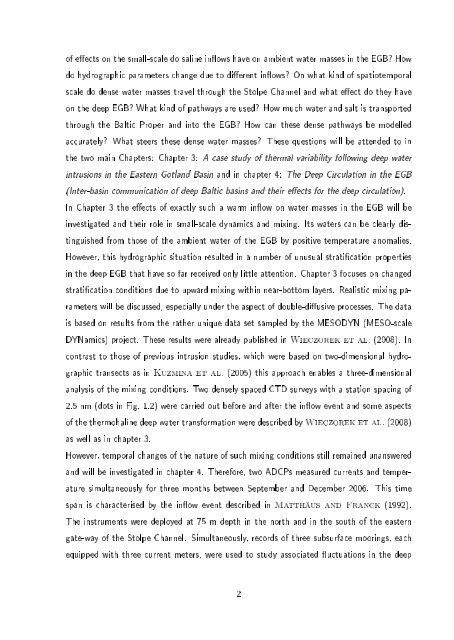Baltic Sea
Baltic Sea
Baltic Sea
You also want an ePaper? Increase the reach of your titles
YUMPU automatically turns print PDFs into web optimized ePapers that Google loves.
of eects on the small-scale do saline inows have on ambient water masses in the EGB? How<br />
do hydrographic parameters change due to dierent inows? On what kind of spatiotemporal<br />
scale do dense water masses travel through the Stolpe Channel and what eect do they have<br />
on the deep EGB? What kind of pathways are used? How much water and salt is transported<br />
through the <strong>Baltic</strong> Proper and into the EGB? How can these dense pathways be modelled<br />
accurately? What steers these dense water masses? These questions will be attended to in<br />
the two main Chapters: Chapter 3: A case study of thermal variability following deep water<br />
intrusions in the Eastern Gotland Basin and in chapter 4: The Deep Circulation in the EGB<br />
(Inter-basin communication of deep <strong>Baltic</strong> basins and their eects for the deep circulation).<br />
In Chapter 3 the eects of exactly such a warm inow on water masses in the EGB will be<br />
investigated and their role in small-scale dynamics and mixing. Its waters can be clearly distinguished<br />
from those of the ambient water of the EGB by positive temperature anomalies.<br />
However, this hydrographic situation resulted in a number of unusual stratication properties<br />
in the deep EGB that have so far received only little attention. Chapter 3 focuses on changed<br />
stratication conditions due to upward mixing within near-bottom layers. Realistic mixing parameters<br />
will be discussed, especially under the aspect of double-diusive processes. The data<br />
is based on results from the rather unique data set sampled by the MESODYN (MESO-scale<br />
DYNamics) project. These results were already published in Wieczorek et al. (2008). In<br />
contrast to those of previous intrusion studies, which were based on two-dimensional hydrographic<br />
transects as in Kuzmina et al. (2005) this approach enables a three-dimensional<br />
analysis of the mixing conditions. Two densely spaced CTD surveys with a station spacing of<br />
2.5 nm (dots in Fig. 1.2) were carried out before and after the inow event and some aspects<br />
of the thermohaline deep water transformation were described by Wieczorek et al. (2008)<br />
as well as in chapter 3.<br />
However, temporal changes of the nature of such mixing conditions still remained unanswered<br />
and will be investigated in chapter 4. Therefore, two ADCPs measured currents and temperature<br />
simultaneously for three months between September and December 2006. This time<br />
span is characterised by the inow event described in Matthäus and Franck (1992).<br />
The instruments were deployed at 75 m depth in the north and in the south of the eastern<br />
gate-way of the Stolpe Channel. Simultaneously, records of three subsurface moorings, each<br />
equipped with three current meters, were used to study associated uctuations in the deep<br />
2



